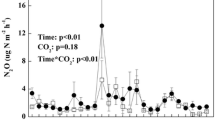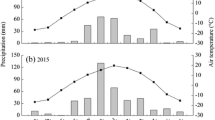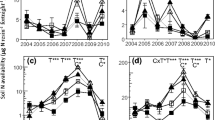Abstract
Long-term exposure of native vegetation to elevated atmospheric CO2 concentrations is expected to increase C inputs to the soil and, in ecosystems with seasonally dry periods, to increase soil moisture. We tested the hypothesis that these indirect effects of elevated CO2 (600 μl l−1 vs 350 μl l−1) would improve conditions for microbial activity and stimulate emissions of nitrous oxide (N2O), a very potent and long-lived greenhouse gas. After two growing seasons, the mean N2O efflux from monoliths of calcareous grassland maintained at elevated CO2 was twice as high as that measured from monoliths maintained at current ambient CO2 (70 ± 9 vs 37 ± 4 μg N2O m−2 h−1 in October, 27 ± 5 vs 13 ± 3 μg N2O m−2 h−1 in November after aboveground harvest). The higher N2O emission rates at elevated CO2 were associated with increases in soil moisture, soil heterotrophic respiration, and plant biomass production, but appear to be mainly attributable to higher soil moisture. Our results suggest that rising atmospheric CO2 may contribute more to the total greenhouse effect than is currently estimated because of its plant-mediated effects on soil processes which may ultimately lead to increased N2O emissions from native grasslands.
Similar content being viewed by others
Author information
Authors and Affiliations
Additional information
Received: 11 September 1997 / Accepted: 20 March 1998
Rights and permissions
About this article
Cite this article
Arnone III, J., Bohlen, P. Stimulated N2O flux from intact grassland monoliths after two growing seasons under elevated atmospheric CO2 . Oecologia 116, 331–335 (1998). https://doi.org/10.1007/s004420050594
Issue Date:
DOI: https://doi.org/10.1007/s004420050594




